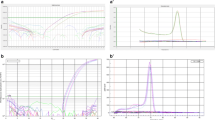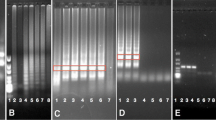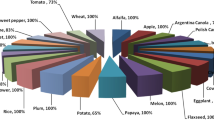Abstract
Seen the growing number of genetically modified (GM) crops being developed, the need for cost- and time-effective detection methods is increasing to enable continuing the necessary effective control on food and feed products. This need can be achieved by performing an intensive screening combined with decision support tools like the CoSYPS matrix which permits reducing the number of events to be identified. To allow an extra covering power of the CoSYPS and to be able to include new EU-authorised GM events, two new SYBR®Green real-time PCR (qPCR) methods targeting two promoter sequences (pNOS and pFMV) were developed. These methods were validated using acceptance parameters such as the specificity, sensitivity and repeatability. In addition, the methods were transferred to a second laboratory, namely the Institute for Health and Consumer Protection, to test the reproducibility. Furthermore, the applicability and practicability of the methods were tested by using proficiency test samples. The two methods allow a specific and sensitive detection of the targets in food and feed samples and can be used efficiently in different laboratories.


Similar content being viewed by others
References
European Parliament (2003) Commission Regulation (EC) No 1829/2003 of the European Parliament and of the Council of 22 September 2003 on genetically modified food and feed. Off J Eur Union L 268:1–23
European Parliament (2003) Commission Regulation (EC) No 1830/2003 of the European Parliament and of the Council of 22 September 2003 concerning the traceability and labelling of genetically modified organisms and the traceability of food and feed products produced from genetically modified organisms and amending Directive 2001/18/EC. Off J Eur Union L 268:24–28
European Commission (2011) Commission Regulation (EU) No 619/2011 of 24 June 2011 laying down the methods of sampling and analysis for the official control of feed as regards presence of genetically modified material for which an authorisation procedure is pending or the authorisation of which has expired. Off J Eur Union L166:9–15
European Parliament (2001) Directive 2001/18/EC of the European Parliament and of the Council of 12 March 2001 on the deliberate release into the environment of genetically modified organisms and repealing Council Directive 90/220/EEC. Off J Eur Union L 106:1–38
Commission of European Communities (2004) Commission Recommendation 2004/787/EC of 4 October 2004 on technical guidance for sampling and detection of genetically modified organisms and material produced from genetically modified organisms as or in products in the context of Regulation (EC) No 1830/2003. Off J Eur Union L 348:18–26
European Union Reference Laboratory: Status of dossiers. http://gmo-crl.jrc.ec.europa.eu/statusofdoss.htm
James C (2011) Global status of commercialized biotech/GM crops: 2011. Executive summary. ISAAA brief (43)
Agbios website. http://www.cera-gmc.org/?action=gm_crop_database
GMO Compass. http://www.gmo-compass.org/eng/home/
Shaw CA, Carter GH, Watson MD, Shaw CH (1984) A functional map of the nopaline synthase promoter. Nucl Acids Res 12(20):7831–7846
Sanger M, Daubert S, Goodman RM (1990) Characteristics of a strong promoter from figwort mosaic virus: comparison with the analogous 35S promoter from cauliflower mosaic virus and the regulated mannopine synthase promoter. Plant Mol Biol 14:433–443
Christensen AH, Sharrock RA, Quail PH (1992) Maize polyubiquitin genes: structure, thermal perturbation of expression and transcript splicing, and promoter activity following transfer to protoplasts by electroporation. Plant Mol Biol 18(4):675–689
Stein AJ, Rodriguez-Cerezo E (2009) The global pipeline of new GM crops. Implications of asynchroneous approval for international trade
Dymond M, Hurr K (2010) The global status of commercialised genetically modified plants (1 July 2008–31 December 2009)
Van den Bulcke M, Lievens A, Barbau-Piednoir E, Mbongolo Mbella G, Roosens N, Sneyers M, Leunda-Casi A (2010) A theoretical introduction to “Combinatory SYBR®Green qPCR Screening”, a matrix-based approach for the detection of materials derived from genetically modified plants. Anal Bioanal Chem 396(6):2113–2123
Van den Bulcke M, Lievens A, Leunda-Casi A, Mbongolo Mbella G, Barbau-Piednoir E, Sneyers M (2008) Transgenic plant event detection. WO/2008/092866
Mbongolo Mbella EG, Lievens A, Barbau-Piednoir E, Sneyers M, Leunda-Casi A, Roosens N, Van den Bulcke M (2011) SYBR®Green qPCR methods for detection of endogenous reference genes in commodity crops: a step ahead in combinatory screening of Genetically Modified Crops in food and feed products. Eur Food Res Technol 232(3):485–496
Barbau-Piednoir E, Lievens A, Mbongolo-Mbella G, Roosens N, Sneyers M, Leunda-Casi A, Van den Bulcke M (2010) SYBR®Green qPCR screening methods for the presence of “35S promoter” and “NOS terminator” elements in food and feed products. Eur Food Res Technol 230(3):383–393
Barbau-Piednoir E, Lievens A, Vandermassen E, Mbongolo-Mbella EG, Leunda-Casi A, Roosens N, Sneyers M, Van den Bulcke M (2012) Four new SYBR®Green qPCR screening methods for the detection of Roundup Ready®, LibertyLink®, and CryIAb traits in genetically modified products. Eur Food Res Technol 234(1):13–23
Broeders S, Papazova N, Van den Bulcke M, Roosens N (2012) Book chapter: development of a molecular platform for GMO detection in food and feed on the basis of “combinatory qPCR” technology. In: Rodríguez PH, Ramirez APG (eds) Polymerase chain reaction. InTech, Rijeka, pp 363–404
International Standard ISO 17025 (2005) General requirements for the competence of testing and calibration laboratories. International Organisation for Standardisation, Genève, Switzerland
Rozen S, Skaletsky H (2000) Primer 3 on the WWW for general users and for biologist programmers. Methods Mol Biol 132:365–386
Rice P, Longden I, Bleasby A (2000) EMBOSS: the European molecular biology open software suite. Trends Genet 16(6):276–277
Sarachu M, Colet M (2005) wEMBOSS: a web interface for EMBOSS. Bioinformatics 21(4):540–541
American Oil Chemists’ Society. https://secure.aocs.org/crm/index.cfm
Institute for Reference Materials and Measurements. http://irmm.jrc.ec.europa.eu/REFERENCE_MATERIALS_CATALOGUE/CATALOGUE/Pages/index.aspx
International Standard ISO 21571 (2005) Foodstuffs—methods of analysis for the detection of genetically modified organisms and derived products—nucleic acid extraction. International Organisation for Standardisation, Genève, Switzerland
European Union Reference Laboratory (2006) Sampling and DNA extraction of cotton seeds. Report from the Validation of the “CTAB/Genomic-tip 20” method for DNA extraction from ground cotton seeds. http://gmo-crl.jrc.ec.europa.eu/summaries/281-3006%20Cotton_DNAExtr.pdf
Arumuganathan K, Earle E (1991) Nuclear DNA content of some important plant species. Plant Mol Biol Rep 9(3):208–218
International Standard ISO 5725–2 (1994) Accuracy (trueness and precision) of measurement methods and results—part 2. International Organisation for Standardisation, Genève, Switzerland
Association Française de Normalisation (AFNOR) (2003) XP V 03-020-2 Produits alimentaires—Détection et quantification des organismes végétaux génétiquement modifiés et produits dérivés—Partie 2: méthodes basées sur la réaction de polymérisation en chaîne
Sambrook J, Russell DW (2001) Molecular Cloning, a laboratory manual. Cold Spring Harbour Laboratory Press
European Network of GMO Laboratories (ENGL) (2008) Definition of Minimum Performance Requirements for Analytical Methods of GMO Testing. http://gmo-crl.jrc.ec.europa.eu/doc/Min_Perf_Requirements_Analytical_methods.pdf
European Network of GMO Laboratories (ENGL) (2011) Verification of analytical methods for GMO testing when implementing interlaboratory validated methods. http://gmo-crl.jrc.ec.europa.eu/doc/ENGL%20MV%20WG%20Report%20July%202011.pdf
International Standard ISO 24276 (2006) Foodstuffs—methods of analysis for detection of genetically modified organisms and derived products—general requirements and definitions. International Organisation for Standardisation, Genève, Switzerland
Donohoe GG, Laaksonen M, Pulkki K, Ronnemaa T, Kairisto V (2000) Rapid single-tube screening of the C282Y hemochromatosis mutation by real-time multiplex allele-specific PCR without fluorescent probes. Clin Chem 46(10):1540–1547
Herrmann MG, Durtschi JD, Wittwer CT, Voelkerding KV (2007) Expanded instrument comparison of amplicon DNA melting analysis for mutation scanning and genotyping. Clin Chem 53(8):1544–1548
Acknowledgments
This work was financially supported by the British Food Standard Agency (FSA, contract G03032) and the German Federal Office of Consumer Protection and Food Safety (BVL) through the Project GMOseek, under the European ERA-NET consortium SAFEFOODERA. Sequencing was performed at the Platform Biotechnology and Molecular Biology of the Scientific Institute of Public Health (WIV-ISP).
Author information
Authors and Affiliations
Corresponding author
Rights and permissions
About this article
Cite this article
Broeders, S., Barbau-Piednoir, E., Vandermassen, E. et al. New SYBR®Green methods targeting promoter sequences used for screening of several GM events pending for authorisation in Europe. Eur Food Res Technol 236, 537–547 (2013). https://doi.org/10.1007/s00217-013-1910-4
Received:
Revised:
Accepted:
Published:
Issue Date:
DOI: https://doi.org/10.1007/s00217-013-1910-4




